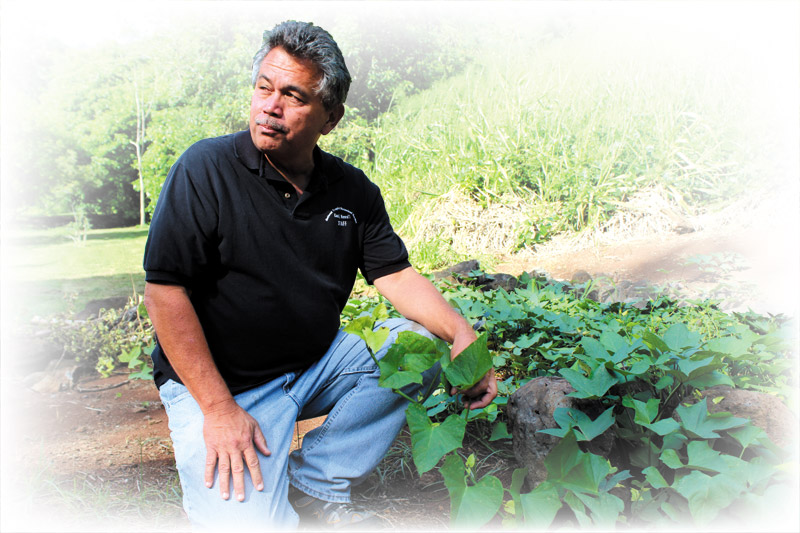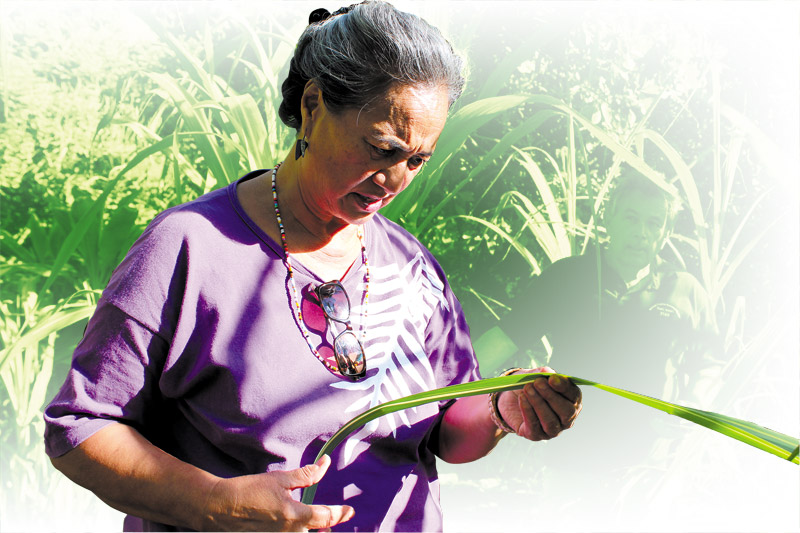‘Hawaiian Life’ Comes Alive

Michael DeMotta, curator for National Tropical Botanical Garden’s Living Collections, in a crop of ‘uala (sweet potatoes).
Brave voyagers from Polynesia crossed unchartered oceanic territory in double-hulled canoes more than 1,000 years ago and discovered one of the most remote landmasses on Earth, the Hawaiian islands. These savvy sailors needed to bring supplies that would allow them to settle into new territory. Among these items were the roots, seeds and cuttings of what are now called canoe plants. They were a source of food and medicine, and were used for necessities like bedding.
“We survived for many, many centuries with only these plants — these plants and makai, the ocean,” says cultural practitioner kumu Sabra Kauka.
In honor of these more than two dozen plants that traversed great distances with their ancient mariner companions, National Tropical Botanical Garden recently revamped its Hawaiian Life: Canoe Garden in Lāwa‘i Valley. Located in McBryde Garden on the south shore, the natural exhibition features new kalo lo‘i (taro patches), crops like ‘uala (sweet potatoes) and kō (sugar-cane), as well as other upgraded aspects like a traditional thatched hale, hula mound, paved path, and a star compass representing what early Polynesian voyagers would have used on their journeys.
One of the most prominent features of the renovated garden are the kalo lo‘i, which were modeled after the terraces at Lima-huli Garden and Preserve in Hā‘ena.
“They are really helping our visitors and people that come here to really get a visual of how our kūpuna lived in a place like Hawai‘i — sustainably for many, many centuries,” says Chipper Wichman, director and CEO of NTBG, during a recent opening ceremony for the canoe garden.

Cultural practitioner kumu Sabra Kauka examines the leaves of a sugarcane plant at NTBG’s revitalized Hawaiian Life: Canoe Garden exhibition.
Canoe plants ensured that settlers could survive on uninhabited islands. Once they arrived, Hawaiians had to be resourceful and discovered inaugural ways of propagating various species, including planting taro in wetland fields.
“It was so productive that it became the staple food,” says Michael DeMotta, curator for Living Collections at NTBG.
The pounded root of the plant was fermented and kept its nutritional value for quite some time, which is one of the reasons why it became such a popular food choice for native people.
Poi was, and still is, a predominant food source in the Hawaiian diet.
Another reason the canoe plants are prominently featured at the rejuvenated garden is that besides providing nutritional and medical value, they are steeped in the culture.
“The lineage of the plants goes back with the lineage of the people,” DeMotta adds.
In fact, each plant is tied to its own story. Kalo, for example, represents the “staff of life.” The story goes that Hawaiian gods Wākea and Ho‘ohokulani named their second child Hāloa after their first son was stillborn. They eventually buried their first-born child where a kalo plant subsequently grew. Hāloa, who the Hawaiian people are believed to be the descendant from, went on to nurture the plant that sprouted from his older brother. The tale is said to serve as a reminder that the Earth will provide if nourished and properly cared for.
“As long as this plant is growing on this earth, we will be, too,” says Kauka. “Should this plant disappear, human beings will be gone, too.”
Placards installed near each of the canoe plants at NTBG are just one of the many new facets of the Hawaiian Life: Canoe Garden that visitors can use to learn these facts and gain a sense of appreciation for the sustainable lifestyle that was once so prevalent in Hawai‘i. Each species served a physical and spiritual purpose that impacts and helps preserve the native culture today, and NTBG is making sure this knowledge continues to be passed along for years to come.
Visit ntbg.org for more information.




